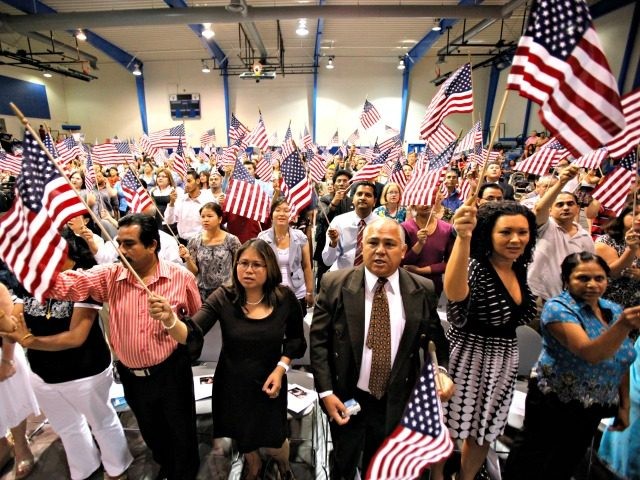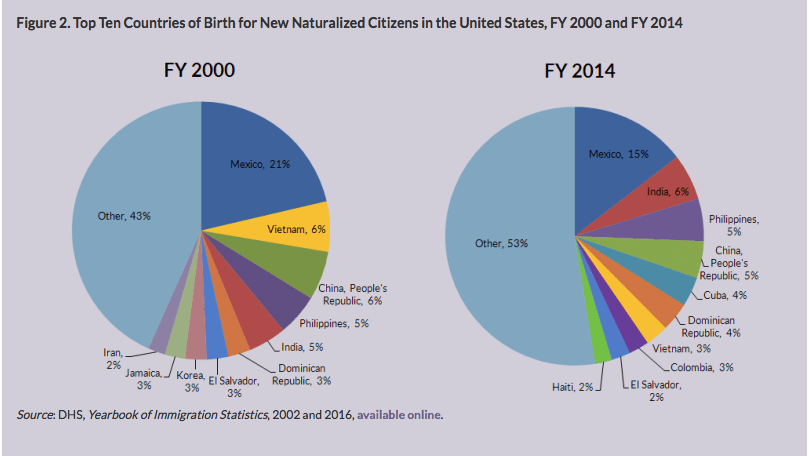Due to the Obama Administration’s effort encouraging immigrants to become U.S. citizens to “fully participate in civic life” and a desire to vote in the 2016 presidential election, the number of naturalization applications have increased substantially in recent months, according to the Migration Policy Institute.
According to a recent MPI report, during the first two quarters of fiscal year 2016 (October 2015 to March 2016) U.S. Citizenship and Immigration Services (USCIS) received 440,000 applications for naturalization. The application level represented a 21 percent increase over the 365,000 applications submitted during the same timeframe in FY 2015.
“This increase can partly be attributed to the citizenship awareness campaign launched by the White House Task Force on New Americans, as well as a desire to vote in the 2016 national elections,” MPI’s report reads.
In recent years, Mexico has been the top country of origin for immigrants seeking U.S. citizenship. As MPI details, in FY 2014, 15 percent of the 653,416 immigrants who naturalized were Mexican (95,889). India ((37,854), at six percent, was the second-most country of origin, followed by the Philippines (34,591) with five percent, China (30,284) also five percent, as well as Cuba (24,092) and the Dominican Republic (23,775), both with four percent.
“Nationals of these six countries accounted for close to 38 percent of all naturalizations. Other leading countries of origin included Vietnam (18,837 or 3 percent), Colombia (16,478, 3 percent), El Salvador (15,598, 2 percent), and Haiti (13,676, 2 percent),” MPI explained in the report.
According to MPI, from FY 2000 – FY 2014 Mexico has been the top country of origin for immigrants seeking to naturalize and nearly half of the estimated 42.4 million immigrants in the U.S. have already become U.S. citizens.
Of those who naturalized in FY 2014, more than half live in just four states with 21 percent residing in California (140,234), 12 percent in Florida (79,637), 12 percent in New York (77,717), and eight percent in Texas (52,879).
Over the past two decades or so the number of immigrants who have become U.S. citizens has skyrocketed above historic levels. From 1911 – 1993 the number of immigrants who became U.S. citizens hovered around the low end of between 39,000 and 485,000. In 1996, however, over a million immigrants naturalized.
“Three federal laws passed in 1996—the Personal Responsibility and Work Opportunity Reconciliation Act (PRWORA), the Illegal Immigration Reform and Immigrant Responsibility Act (IIRIRA), and the Anti-Terrorism and Effective Death Penalty Act (AEDPA)—limited access to public benefits and legal protections for noncitizens, thereby encouraging more immigrants to apply for naturalization,” MPI explained in its report.
Since 1996, the level of naturalization has remained comparatively high, never again dropping below six-figures. In 2008, the number of naturalizations hit an all time high, again due to what MPI said was a push for immigrants to be able to vote.
“The 59 percent increase in naturalizations (from 660,477 to 1,046,539) between FY 2007 and FY 2008 is the result of naturalization campaigns launched ahead of the 2008 presidential elections and an impending increase in naturalization application fees (which took effect on July 30, 2007),” the report reads, noting that the swell of applications served to create a backlog, which the government solved by simply expediting processing times.



COMMENTS
Please let us know if you're having issues with commenting.